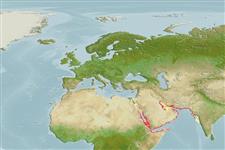Classification / Names
ชื่อสามัญ | ชื่อพ้อง | Catalog of Fishes(สกุล, ชนิด) | ITIS | CoL | WoRMS | Cloffa
>
Eupercaria/misc (Various families in series Eupercaria) >
Labridae (Wrasses) > Corinae
Etymology: Hemigymnus: Greek, hemi = half + Greek, gymnos = naked (Ref. 45335).
Environment: milieu / climate zone / depth range / distribution range
นิเวศวิทยา
เกี่ยวกับทะเล,น้ำเค็ม เกี่ยวกับหินโสโครก; ระดับความลึก 1 - 20 m (Ref. 93095). Tropical
Western Indian Ocean: Red Sea, Gulf of Tadjoura, east in the Gulf of Aden at least to Sikha Island, southwest of Al Mukallah, Yemen.
ขนาด / น้ำหนัก / Age
Maturity: Lm ? range ? - ? cm
Max length : 36.5 cm TL เพศผู้/กระเทย; (Ref. 93095)
Short description
สัณฐานวิทยา | ความยาวต่างๆ
This species is distinguished by the following set of characters: gill rakers 20-23 (rarely 23); long pelvic fins, reaching anus in mature females and to or beyond origin of anal fin in males, one to spinous portion of fin; small juveniles are dark green, mottled with light yellowish green, with a white bar from anterior part of dorsal fin to abdomen, 4 faint narrower bars posteriorly, a pale bar on nape, 2 ventrally on chest; larger juveniles are dark brown with more distinct pale yellow bars; body of small females black with 5 white bars, progressively narrower posteriorly, the last posteriorly on caudal peduncle faint, the first two expanding ventrally; head white with a curving black bar from nape to eye; snout and interorbital are green with irregular pink bands radiating from eye; pectoral-fin rays yellow, membranes transparent; female in the process of sex change, indicated by the golden scale centers dorsally on the first dark bar of the body and on the dark olive bar of the nape; pelvic fins pale blue with orange streaks; body of males dark green, with spindle-shaped scales edged in light green; three pale gray bars on anterior two-thirds of body that broaden ventrally, the scale edges narrowly light green; first dark bar on body, ending at base of pectoral fin, with green margins and vertically elongate golden centers, many merging above and below, more as irregular vertical green and golden lines than as scale patterns; curving dark green bar of nape with golden scale centers, merging with a broad light yellowish brown band with irregular green bands that passes through eye onto snout; cheek with a broad near-white area, sparsely and faintly spotted with green, shading ventrally to blue; upper lip mainly greenish yellow; chest and abdomen pale blue with orange scale centers; pectoral-fin base in a large deep blue spot (Ref. 93095).
Occurs on coral reefs and adjacent habitats, on sand and coral rubble. The fish take a mouthful of sand and gravel from the substratum, where small fossorial prey are sorted out within the mouth and pharynx, and inorganic fragments are forcefully ejected from of the mouth. May also feed opportunistically on larger prey (crabs, echinoids, molluscs, ophiuroids, polychaetes) (Ref. 93095). Large breeding males in the Red Sea observed to exhibit h a reversal of the black-and-white barred color pattern of the body similar to H. fasciatus (Ref. 34222).
Life cycle and mating behavior
วัยเจริญพันธุ์ | การสืบพันธุ์ | การวางไข่ | เซลสืบพันธ์ของเพศเมีย(ไข่) | ความดกของไข่ | ตัวอ่อน
Oviparous, with distinct pairing during breeding (Ref. 205).
Randall, J.E., 2013. Review of the Indo-Pacific labrid fish genus Hemigymnus. J. Ocean Sci. Found. 6:2-18. (Ref. 93095)
IUCN Red List Status (Ref. 130435)
Threat to humans
Harmless
Human uses
ข้อมูลเพิ่มเติม
ชื่อสามัญชื่อพ้องกลไกการเผาผลาญพลังงานผู้ล่าการศึกษาเกี่ยวกับผลกระทบของสารประกอบทางเคมีที่เป็นอันตรายต่อสิ่งมีชีวิต ประชากร และสิ่งแวดล้อมการสืบพันธุ์วัยเจริญพันธุ์การวางไข่การรวมกลุ่มวางไข่ความดกของไข่เซลสืบพันธ์ของเพศเมีย(ไข่)Egg development
Age/SizeการเจริญเติบโตLength-weightLength-lengthLength-frequenciesความยาวต่างๆสัณฐานวิทยาตัวอ่อนพลวัตของสัตว์น้ำวัยอ่อนการทดแทนที่อุดมสมบรูณ์BRUVS
อ้างอิงการเพาะเลี้ยงสัตว์น้ำประวัติการเพาะเลี้ยงสัตว์น้ำสายพันธุ์พันธุศาสตร์ElectrophoresesอัตราพันธุกรรมโรคการแปรรูปNutrientsMass conversion
ผู้ร่วมมือรูปภาพหลายรูปStamps, Coins Misc.เสียงปลามีพิษ เช่น ปลาปักเป้าความเร็วรูปแบบการว่ายน้ำพื้นที่เหงือกOtolithsสมองวิสัยทัศน์
เครื่องมือ
Special reports
Download XML
แหล่งที่มาจากอินเตอร์เน็ต
Estimates based on models
Preferred temperature (Ref.
123201): 26.9 - 29.2, mean 28.2 °C (based on 249 cells).
Phylogenetic diversity index (Ref.
82804): PD
50 = 0.6250 [Uniqueness, from 0.5 = low to 2.0 = high].
Bayesian length-weight: a=0.00977 (0.00470 - 0.02030), b=3.07 (2.89 - 3.25), in cm total length, based on LWR estimates for this (Sub)family-body shape (Ref.
93245).
ระดับชั้นอาหาร (Ref.
69278): 3.5 ±0.4 se; based on size and trophs of closest relatives
ความสามารถในการกลับคืนสู่ปกติ (Ref.
120179): ขนาดกลาง, เวลาต่ำสุดที่จะทำให้ประชากรเพิ่มขึ้นเป็น 2 เท่าใช้เวลา 1.4 - 4.4 ปี (Preliminary K or Fecundity.).
Fishing Vulnerability (Ref.
59153): Low to moderate vulnerability (27 of 100).
